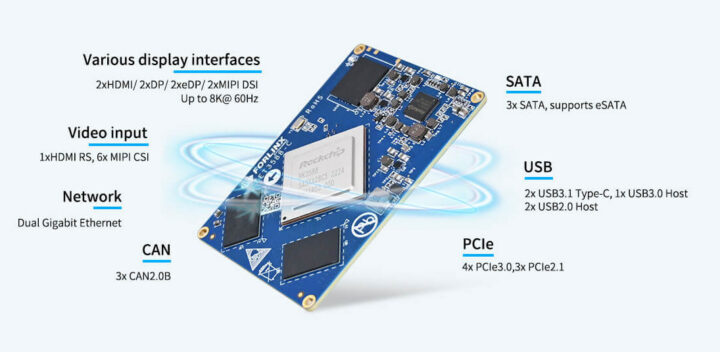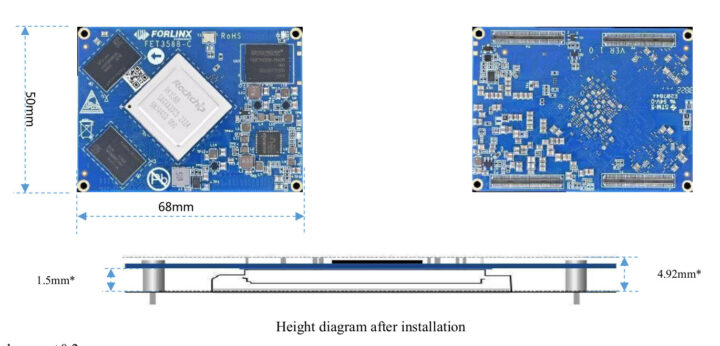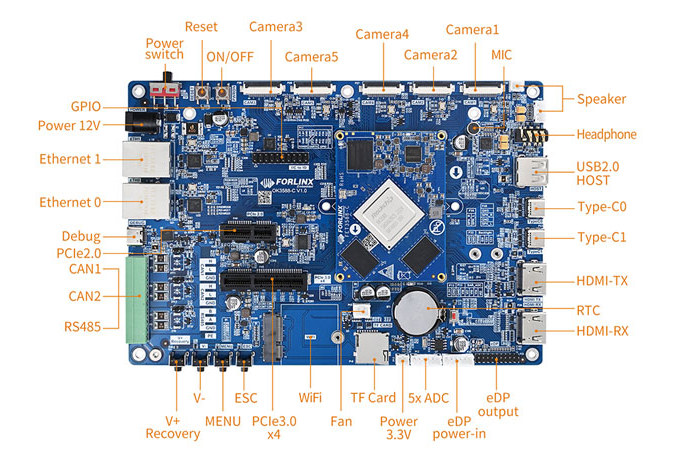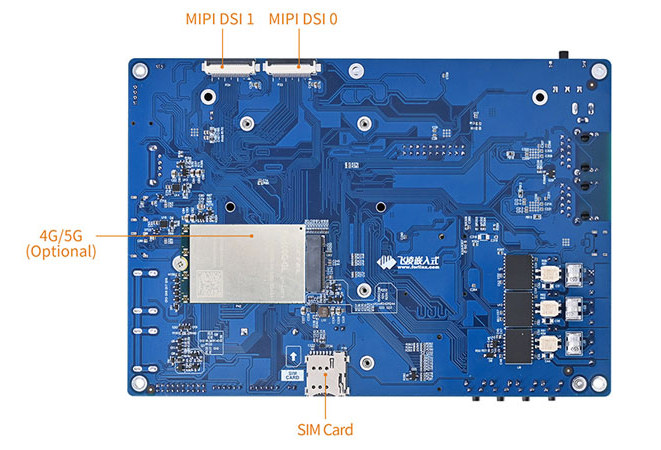Forlinx FET3588-C is a relatively compact Rockchip RK3588 system-on-module measuring 68x50mm and exposing many of the processor’s I/Os through four 100-pin high-density connectors.
The module ships with up to 8GB LPDDR4x and 64GB eMMC flash, and the company also provides the OK3588-C development board for evaluation with HDMI output and input, two MIPI DSI interfaces, five camera connectors, dual Gigabit Ethernet, M.2 sockets for WiFi and 4G/5G cellular connectivity, and more.
Forlinx FET3588-C RK3588 system-on-module
- SoC – Rockchip RK3588 octa-core processor with 4x Arm Cortex-A76 cores @ up to 2.4 GHz, 4x Arm Cortex-A55 cores, Arm Mali-G610 MP4 GPU with support for OpenGL ES3.2, OpenCL 2.2, Vulkan1.1, 6 TOPS NPU, 48MP ISP, 8Kp60 video decoding, 8Kp30 video encoding
- System Memory – 4GB or 8GB LPDDR4x (16GB planned)
- Storage – 32GB or 64GB eMMC 5.1 flash (128GB planned)
- Carrier board interface – 4x high-density 100-pin board-to-board connectors
- Storage – Up to 3x SATA 3.0 (multiplexed with PCIe and USB Host), 1x SD card
- SDIO – 1x SDIO for WiFI, 1x SDIO for SD card
- Display I/F
- Up to 2x HDMI 2.1 output up to 8Kp60
- 1x HDMI 2.0 input
- Up to 2x eDP (multiplexed with HDMI) up to 4Kp60
- 2x DisplayPort up to 8Kp30
- 2x 2-lane MIPI DSI supports up to 4Kp60
- BT.1120 RGB interface up to 1920×1080 @ 60 Hz
- Camera
- 2x MIPI DC PHY
- Up to 4x MIPI CSI inputs configurable as 4x 2-lane, 1x 4-lane, or 2x 4-lane
- DVP interface
- Audio
- Up to 4x I2S (2x 8-channel and 2x 2-channel)
- 2x S/PDIF
- 2x PDM microphone inputs
- 1x DSM PWM
- Networking – 2x Gigabit Ethernet
- USB
- 1x USB 3.1 Gen1 host up to 5 Gbps shared with PIPE PHY2
- 2x USB 3.1 Gen1 OTG shared with DP Tx
- 2x USB 2.0 host
- PCIe – 1x PCIe 3.0 x4 (8 Gbps), up to 3x PCIe 2.0 x1 (5 Gbps)
- Serial – Up to 10x UART, up to 3x CAN bus
- Low-speed I/Os – Up to 5x SPI, 9x I2C, 16x PWM
- ADC – Up to 8x ADC inputs
- GPIO – Up to TDB GPIOs
- Supply Voltage – 12V DC (TBC)
- Temperature Range – 0C ~ +80°C
The company provides support for Android 12, and both Ubuntu and (Yocto?) Linux are shown as TBD (to be determined) on the product page. It looks somewhat similar to the RD-RK3588 CPU module we covered earlier this year, but that one came from Aliexpress with limited info, and Forlinx does have a website and an English-speaking staff (at least the sales).
Documentation is not public, but customers should get a software user manual, the Linux kernel source code, the file system, an OS image, and a VM Ubuntu image for Android 12 development, as well as a hardware user manual, the carrier board schematics and PCB, a datasheet, as well as the carrier board and SoM DXF files.
While the Forlinx FET3588-C is slightly larger than a Raspberry Pi Compute Module 4, the performance is roughly equivalent to three or four Raspberry Pi CM4 modules combined with one and a half Google Coral AI accelerators, plus you get SATA, PCIe Gen3, HDMI 2.1 8K video output, among many other peripheral interfaces and I/Os.
OK3588-C development board
Forlinx also provides the OK3588-C development board for evaluation of the Rockchip RK3588 system-on-module and early software development before the custom carrier board is ready.
Forlinx OK3588-C specifications:
- SoM – Forlinx FET3588-C described above
- Storage – MicroSD card socket
- Video Outputs
- 1x HDMI outputs up to 8Kp60
- 2x DisplayPort USB-C interfaces up to 8Kp30 (multiplexed with USB 3.1 Gen1)
- eDP connector up to 4Kp60 (optional 1080p60 display can be provided)
- 2x MIPI DSI connectors up to 4Kp60 (optional 7-inch 1024×600 @ 30 Hz panel)
- Video Inputs
- 1x HDMI input up to 4Kp60
- 5z MIPI camera connectors
- Audio – 3.5mm headphone/speaker jack, header for speaker, built-in microphone
- Networking
- 2x Gigabit Ethernet RJ45 ports
- Optional Wi-Fi 6 and Bluetooth 5.3 via M.2 module (top of the board)
- Optional 4G/5G cellular via M.2 module and SIM card slot (bottom side of the board)
- USB
- 2x USB 3.1 Gen1 Type-C ports
- 1x USB 2.0 Type-A port
- Serial
- 1x UART up to 4 Mbps via header
- 2x CAN buses and 1x RS485 via terminal block
- I/O headers – GPIO header with up 9x GPIOs, analog input header with 5x ADC up to 1 Msps
- Expansion
- PCIe 3.0 x4 slot up to 8 Gbps
- PCIe 2.0 x1 slot
- M.2 sockets for wireless connectivity
- Misc – Power button, Reset button, RTC + battery, fan header
- Power Supply – 12V via DC jack
- Dimensions – TBD
The Forlinx OK3588-C devkit offers more interfaces than the Firefly ITX3588J mini-ITX motherboard and Banana Pi RK3588_MB motherboard, but somehow does lack SATA ports. There should be a cooling solution as well since the Rockchip RK3588 processor does require some active or passive cooling, but Forlinx does not mention anything about it.
The 4GB+32GB and 8GB+64GB variants of Forlinx’ Rockchip RK3588 system-in-module are available now in small batch production, while the model with 16GB RAM and 128GB eMMC flash is being worked on. Pricing has not been disclosed. More details may be found on the product page.

Jean-Luc started CNX Software in 2010 as a part-time endeavor, before quitting his job as a software engineering manager, and starting to write daily news, and reviews full time later in 2011.
Support CNX Software! Donate via cryptocurrencies, become a Patron on Patreon, or purchase goods on Amazon or Aliexpress








